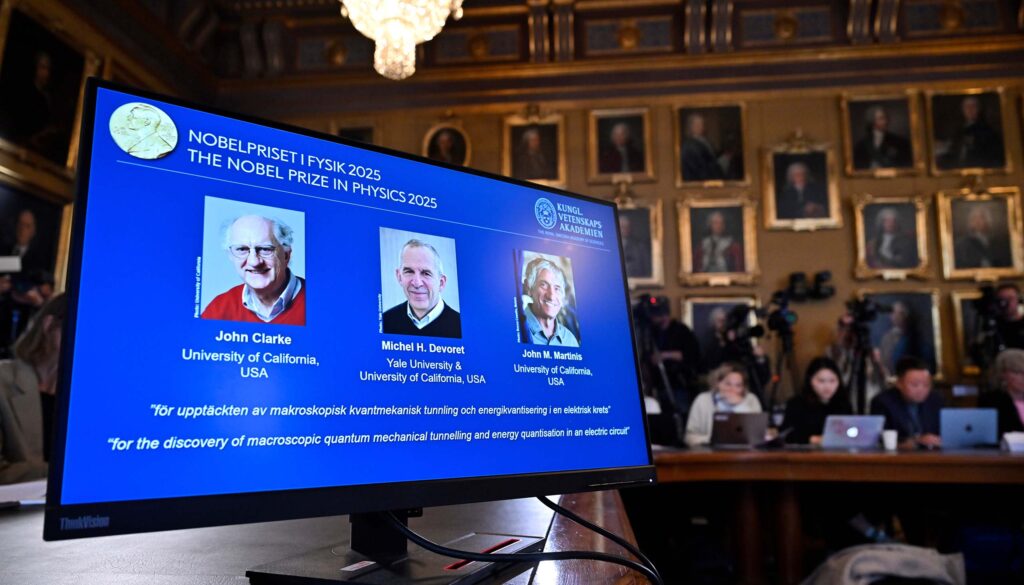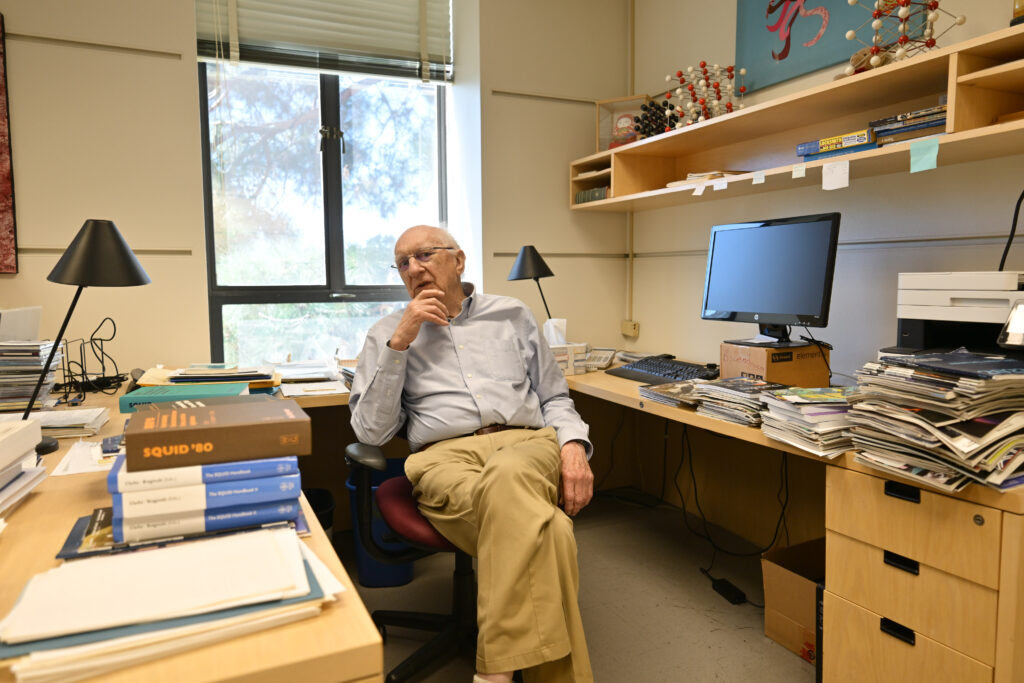John Clarke, an emeritus professor of physics at the University of California, Berkeley, was awarded the 2025 Nobel Prize in Physics for his work on quantum tunneling, one of many strange aspects of quantum mechanics.
Clarke shared the prize with two other physicists, Michel H. Devoret and John M. Martinis, who at the time of their prize-winning research were at UC Berkeley. Devoret is now at Yale University and UC Santa Barbara, while Martinis is at UC Santa Barbara.
The Nobel Prize committee honored the three “for the discovery of macroscopic quantum mechanical tunneling and energy quantization in an electric circuit.” The discovery laid the foundation for superconducting quantum bits, or qubits, at the heart of many of today’s quantum computers.
Clarke is the 27th UC Berkeley faculty member to win a Nobel Prize and the fourth winner in the past five years. In 2021, David Card shared the Sveriges Riksbank Prize in Economic Sciences in Memory of Alfred Nobel, while in 2020, Jennifer Doudna shared the Nobel Prize in Chemistry, and Reinhard Genzel shared the Nobel Prize in Physics.

Christine Olsson/TT News Agency via AP
Berkeley Chancellor Rich Lyons noted that the campus is already invested in major quantum computing initiatives, highlighted by the visit to campus last week of California Gov. Gavin Newsom to sign legislation creating quantum innovation zones around the state.
“Berkeley’s ability to play an essential role in this initiative — and similar ones across the scientific spectrum — would not be possible without extraordinary scholars like John Clarke,” he said. “Their work and discoveries in fundamental scientific research so often set the stage for the development of new technologies, products, and services that support the prosperity, health and well-being of people around the world.”
“Their research has opened the door to the next generation of quantum technologies, including quantum cryptography, computers and sensors — breakthroughs that will change how we do everything from discovering new drugs to stopping destructive cyberattacks,” UC President James B. Milliken said in a statement.
Quantum tunneling is the ability of particles, such as electrons, to move or tunnel through barriers that, according to classical physics, they should not be able to breach. This had been demonstrated many times in the atomic realm, as in the radioactive decay of atoms. In the early 1980s, the three Nobel laureates demonstrated this effect in a larger system — a simple electrical circuit incorporating a superconductor, which allows current to flow without resistance.
“The fact that you can see the quantum world in an electrical circuit in this very direct way was really the source of the prize,” said Irfan Siddiqi, the chair of UC Berkeley’s Department of Physics and a former postdoctoral fellow in Devoret’s Yale lab.
“This work laid the foundation for exploring macroscopic quantum physics in superconducting circuits,” the Nobel committee wrote in its summary of the research.

UC Berkeley
In a phone call with the Nobel committee patched into the press conference in Stockholm, Clarke said that the award took him by surprise.
“To put it mildly, it was the surprise of my life,” he said. That his work was Nobel Prize worthy “had not occurred to us in any way.”
He noted that this discovery would not have happened without the work of the other two Nobelists. “I was in principle the leader of the group, of course, but their contributions are just overwhelming.”
Clarke, who has been on the UC Berkeley faculty since 1969, led one of several groups in the 1980s that were trying to demonstrate macroscopic quantum tunneling (MQT) in superconducting circuits, based on predictions by Anthony Leggett, who later won a Nobel Prize in Physics for explaining the theory behind superfluid helium. Clarke was also a scientist at the Department of Energy’s Lawrence Berkeley National Laboratory, which he joined in 1969, retiring as a faculty senior scientist in the Materials Sciences Division in 2010.
Working with Martinis, then a graduate student, and postdoctoral fellow Michel Devoret from the Centre d’Etudes Nucleaires de Saclay, France, Clarke devised an experiment that he thought would confirm the existence of MQT beyond a reasonable doubt.
Siddiqi said that the experiment, in 1984 and 1985, used a quantum device called a Josephson junction to form the quantum version of a classical pendulum. The experiment clearly proved that the circuit-based oscillator had quantized energy levels, like the quantized or discrete energy levels of an atom
“They showed that a macroscopic circuit kind of behaved like a single atom. It had levels,” he said. They also showed that a quantum state in one circuit could tunnel out and into an adjacent configuration, “which of course is quantum tunneling and uniquely quantum.”

Brandon Sánchez Mejia/UC Berkeley
The circuit was essentially a qubit, or quantum bit, the basic component of today’s quantum computers.
“That quantization of the energy levels is the source of all qubits,” he said. “This was the grandfather of qubits. Modern qubit circuits have more knobs and wires and things, but that’s just how to tune the levels, how to couple or entangle them. The basic idea that Josephson circuits could be quantized and were quantum was really shown in this experiment.”
In analogy with the single-particle quantum tunneling — that of an alpha particle emerging from a heavy nucleus — the researchers described their system as a “macroscopic nucleus” and foresaw the possibility of building exotic “macroscopic nuclei with wires.”

Jane Scherr for UC Berkeley
Clarke is also known for his work on ultrasensitive detectors called SQUIDs, or superconducting quantum interference devices. He has used SQUIDs in many applications, including detection of NMR signals at ultralow frequencies, geophysics, the nondestructive evaluation of materials and as biosensors.
He is currently collaborating with the Axion Dark Matter Experiment, for which he developed a low-noise superconducting quantum amplifier based on SQUIDS. ADMX is searching for a possible dark matter candidate, the axion. The high-frequency, low-noise quantum SQUID amplifiers he invented for ADMX have since been employed in another area of physics, to read out the superconducting quantum bits, or qubits, for quantum computers.
Clarke was born in 1942 in Cambridge, United Kingdom, and attended Cambridge University, where he earned a BA degree in physics in 1964 and a PhD in physics in 1968. After a postdoctoral fellowship at UC Berkeley he joined the physics faculty in 1969.
Clarke is a Fellow of the Royal Society of London and an Honorary Fellow of Christ’s College, Cambridge. His honors include the University of California’s Distinguished Teaching Award, 1987 California Scientist of the Year, and numerous technology awards including the Fritz London Memorial Award for low temperature physics and the National Academy of Sciences Comstock Prize in physics.

